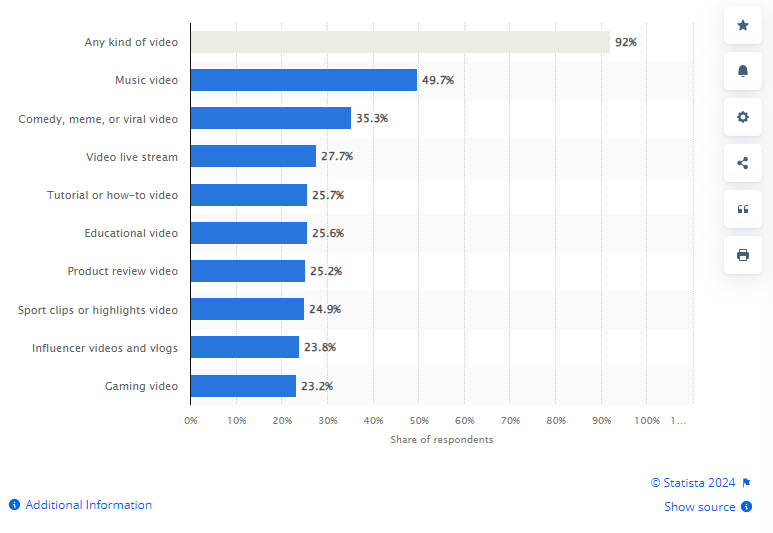If you’re a business owner, you should consider posting video content on social media platforms. Gone are the days when boring, plain texts were enough to capture your audience’s attention. Why?
Video content gets 1200% more shares than text posts. Every day, nearly 8 billion videos are viewed on Facebook. LinkedIn video campaigns get 50% view rates.
Short answer? Start including video marketing in your content creation process. This blog explains which content is most popular and how to create a viral video that converts. Whether you’re a novice or a seasoned pro, this article is tailored to benefit you.
What is Video Content?
Video content refers to any form of content that incorporates video as its primary medium. It encompasses various formats, such as vlogs, animated GIFs, live videos, customer testimonials, recorded presentations, webinars, and more.

Also Read: Personalized Video Marketing: Connecting with Your Audience Like Never Before
What Video Content is Most Popular?

It is crucial to understand the popularity of videos depends on factors such as
- Audience preference
- Social media platforms
- Trends
- Technological advancements
Making videos that are both captivating and genuine, customized to suit your intended audience, is the key.
How do I Start Making Video Content?
Choose a Platform:
Deciding where to publish your video content is your first step. Popular platforms like YouTube, Vimeo, Twitter, Facebook, and IGTV offer diverse audiences.
Tailoring your content to the platform ensures maximum impact. For example, shorter videos with attention-grabbing hooks tend to perform best.
After selecting a platform, plan your video production meticulously. For highly edited content, script every line and plan transitions, b-rolls, and graphics beforehand.
Even spontaneous videos benefit from some level of planning, like outlining topics or selecting shooting locations. Effective planning ensures smoother execution and enhances video quality.
Set Up Your Studio:
Your filming environment, or “studio,” significantly influences video quality. Whether it’s a professional studio or a makeshift setup, prep it before shooting to avoid delays.
Consider factors like noise, lighting, and reverb to ensure optimal recording conditions. Prior scouting prevents unexpected issues during filming.
Edit for Engagement:
Post-filming, focus on editing your video to maximize engagement. Adapt editing techniques to suit your platform and audience.
Maintain a brisk pace, utilize transitions and graphics effectively, and incorporate clear calls-to-action (CTAs) without sounding overly promotional. Prioritize providing value to viewers to drive engagement.
Optimize for SEO:
Optimize your video for search engines, regardless of the platform. Identify popular keywords relevant to your content and incorporate them into titles, descriptions, and tags.
This enhances visibility and increases the likelihood of discovery. Optimized videos can also rank in Google search results, expanding your reach further.
Repost Video Content Across Platforms:
Reposting video content across platforms allows you to leverage your content’s potential on different channels. Adapt the content to suit each platform’s format and audience preferences.
Repurposing snippets or highlights from longer videos ensures relevance and engagement across various social media platforms.
What Videos Go Viral the Most?
Here’s a breakdown of some video content that could blow up the internet:
- Humor: People love to laugh! Funny skits, pranks, and challenges are a surefire way to grab attention.
- Example: Charlie bit my finger – again! (886 million views) [YouTube] This seemingly simple video of two brothers went viral in 2007, spawning countless parodies and cementing its place in internet history.
- Example: Keyboard Cat – (75 million views) [YouTube] This 2009 video of a cat seemingly playing a keyboard took the internet by storm, showcasing the power of unexpected animal behavior.
- Example: Gangnam Style by PSY (5.1 billion views) [YouTube] This K-pop song’s quirky dance moves and infectious energy propelled it to international fame in 2012.
- Example: The Ice Bucket Challenge (17 million videos uploaded) [YouTube] This 2014 challenge raised millions for ALS research, showcasing the power of social media for good.
- Example: 5-Minute Crafts (79.4 million subscribers) [YouTube] This channel is a goldmine for DIY projects and life hacks, demonstrating the vast audience for practical video content.
- Emotional Stories: Videos that evoke strong emotions, whether heartwarming or heartbreaking, can resonate with viewers and be widely shared.
- Example: Unexpected Reunion – Soldier Surprises Kids at School (53 million views) [YouTube] This heartwarming video of a soldier returning home tugs at the heartstrings and reminds us of the power of human connection.
How to Create Viral Video Content?
The virality factor for each social media platform differs. Understand your target audience and see what kind of content they like to consume.
Tip: Identify influencers or accounts within your niche that align with your content goals. Analyze their top-performing viral content and take inspiration from their strategies.
Keep your videos short and sweet to hold viewers’ attention spans. Stay attuned to the latest trends and happenings, infusing your content with timely and shareable elements.
Collaborating with influencers or teaming up with relevant brands can extend your content’s reach and boost engagement. Moreover, authenticity and transparency are paramount for building meaningful connections with your audience.
Furthermore, dive deep into data and metrics to fine-tune your video strategy. Track key engagement metrics like views, likes, comments, and shares to understand what resonates most with your audience.
Experiment with various video formats, styles, and messaging to uncover the secret sauce for virality within your niche. Embrace bold creativity and don’t shy away from taking calculated risks. Remember, viral content often springs from unexpected or unconventional ideas that capture attention and ignite conversations.
By continuously evolving your approach based on insights and audience feedback, you’ll stand a better chance of crafting video content that strikes a chord and drives significant engagement.
Wrapping Up
There is no one formula for creating viral video content. Follow the steps mentioned in this article and keep experimenting. The ability to deliver compelling stories and motivate audiences to act can be used by almost any organization with the correct strategy, a little imagination, and astute decision-making.


